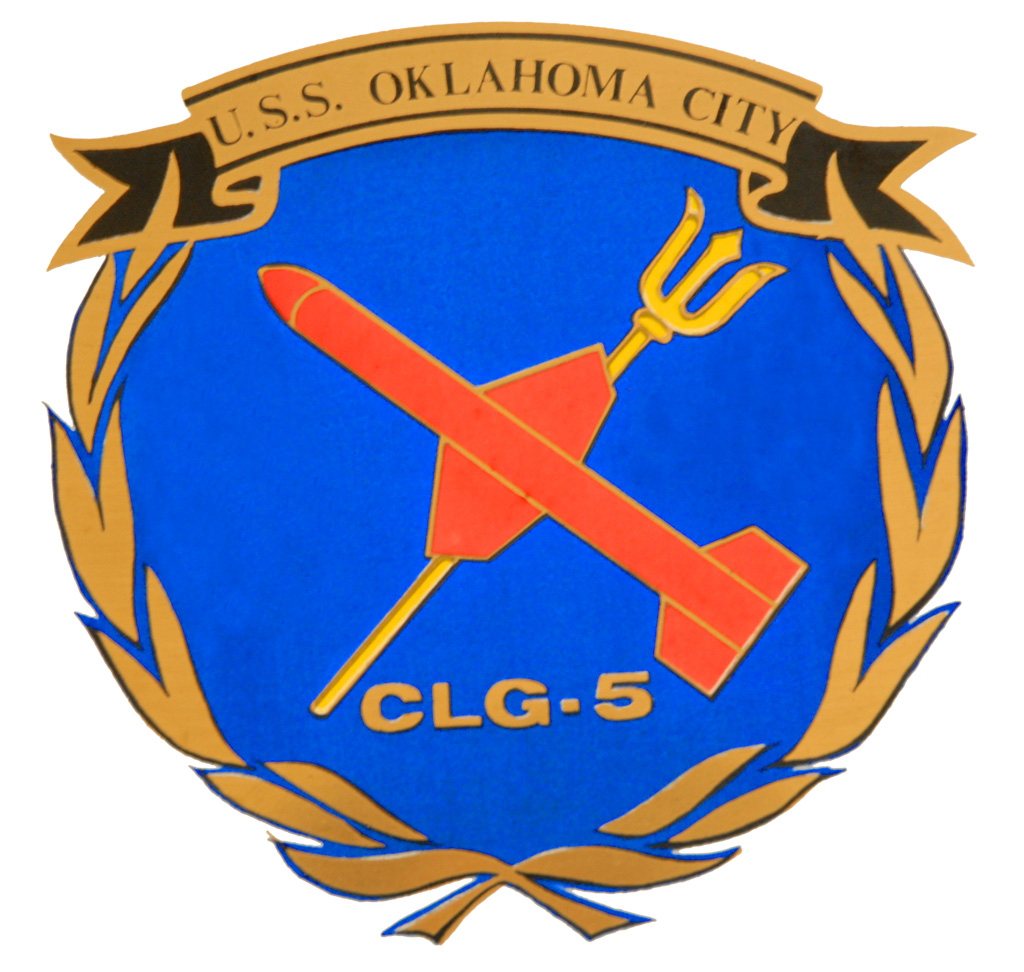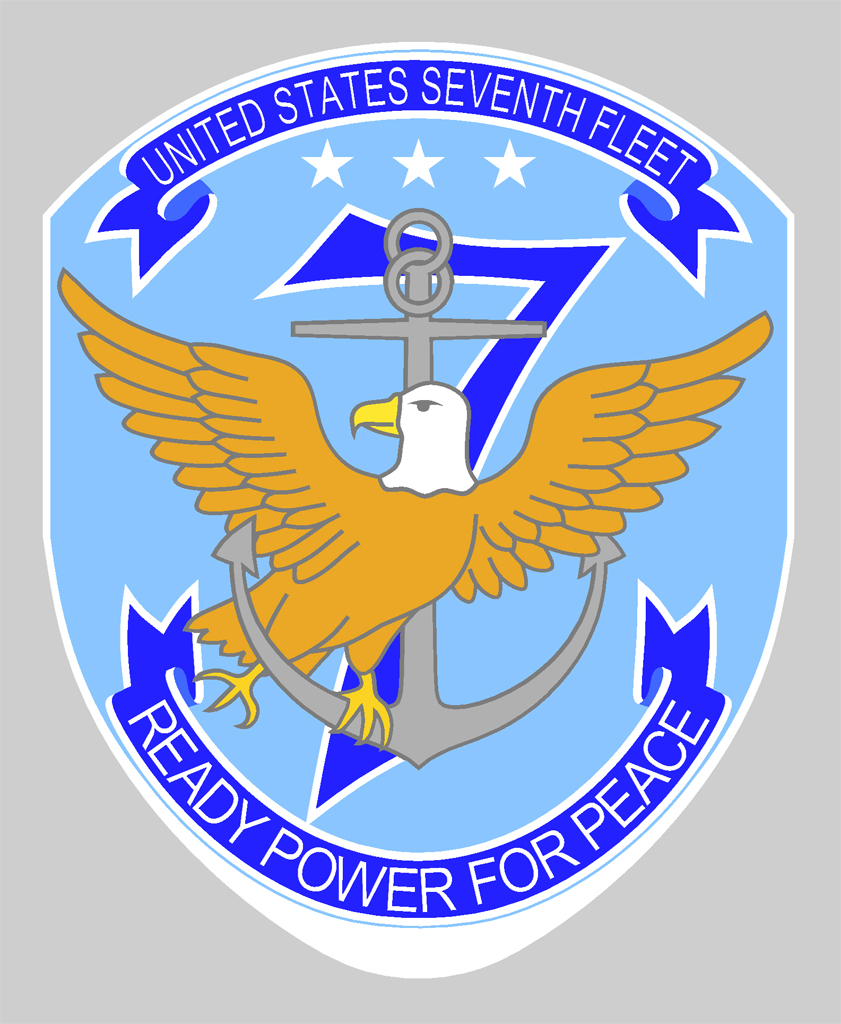The USS Oklahoma City CLG-5/CG-5 was a fleet flagship. As such it carried two crews, one to operate the ship and one to operate the fleet. There were about 900 men in the ship's company and another 300 on the Fleet staff. The two crews were organized separately, but some duties were shared between the two organizations. I describe the Seventh Fleet crew below, for the ship was Seventh Fleet flagship while home ported in Yokosuka, Japan (while I was aboard). However the ship served as First Fleet flagship while home ported in San Diego, and the First Fleet staff organization would have been similar.
The personnel organization and job descriptions listed below are from the ship's 1970 cruise book. The head counts are approximations.

Organization of the ship's crew
The OK CIty crew included about 100 officers and 800 enlisted men. The crew was pretty much organized around the structure and function of the ship. The Departments were organized into weapons, engineering, supply and other functional units. These were subdivided into Divisions dedicated to maintaining and operating specific parts of the ship's equipment. Each Division had a Division Officer who reported to the Department Head. Department Heads reported to the Executive Officer, who reported to the Captain.
Commanding Officer
The Captain was the senior officer in charge of the ship - it was his "boat." He bore full responsibility for everything the ship did and everything that happened on the ship. The CO was responsible for making the ship carry out it's assigned missions.
Executive Officer
The XO was second in command of the ship. He was responsible for ensuring the ship was capable of carrying out it's assigned duties.
Administrative Department
Executive Officer
10 officers
30 men
These men operated the Captain's Office, Personnel Office, Training and Education Office, Public Affairs Office, Post Office,
Chaplain's Assistants, Legal and Master at Arms. They kept ship and personnel records, published the ships newspaper and Sooner
magazine, delivered the mail, ran the ship's radio station and helped with church services, legal assistance, and assigned berthing.
Engineering Department
Engineering Officer
23 officers
A Division
40 men
The "A gang" maintained and operated auxiliary equipment, refrigeration systems, hot water heaters,
boats, air conditioning, laundry equipment, machine shops, the anchor windlasses, steering gear, and evaporators
(fresh water distillation units).
B Division
56 men
These men operated the ship's four boilers and auxiliary equipment in the firerooms. They also tested the ship's
drinking water, boiler water and fuel oil. They were called the "black gang."
E Division
29 men
The electrical division maintained the ship's electrical power systems, lighting and interior communications systems, alarm systems,
gyro compass and movie projectors.
M Division
50 men
They maintained the ship's four engines, four turbo generators and four air compressors. The division provided propulsion,
compressed air and electrical power for the ship.
R Division
27 men
They performed mechanical and structural repairs aboard ship. They maintained fire and flushing systems, drains, damage control
equipment and the watertight integrity of the ship. They operated the metal shop, pipe shop, damage control shop and carpenter shop.
Medical and Dental Department
Medical Officer
3 officers
13 men
They operated and maintained the ships hospital, dental offices, dispensary, pharmacy, X-ray equipment, operating room and clinical
laboratory. They performed sanitation inspections of berthing, mess spaces and food stores, and did vector (pest) control.
Navigation Department
Navigation Officer
2 officers
12 men
The quartermasters were responsible for navigating and piloting the ship and maintenance of navigation equipment. They stood watches
on the quarterdeck, bridge and after steering.
Operations Department
Operations Officer
15 officers
OE Division
20 men
The ET gang maintained electronic equipment including radios, search radars, weather satellite receivers, navigation systems, atmospheric
transponders and test equipment.
OI Division
34 men
The Operations Intelligence division operated the Combat Information Center (CIC). The radarmen provided navigation,
early warning, electronic warfare and gunfire support coordination for the ship, and tracked air and surface contacts.
OL Division
14 men
These men stood watches as lookouts and in CIC. They maintained some passageways and weather decks in the forward superstructure,
including flag spaces. They were also known as Fourth Division.
Supply Department
Supply Officer
11 officers
S-1 Division
26 men
The Stores Division stocked and reordered all material necessary to maintain ship. They also scheduled supply deliveries.
S-2 Division
70 men
These were the mess cooks who prepared four meals a day for the crew. They ran the bake shop.
S-3 Division
41 men
The S-3 division operated the laundry service, barber shop, clothing and small stores, ship's store, soda fountain and vending machines.
S-4 Division
4 men
The Disbursing Office kept payroll records for ship's personnel and Seventh Fleet staff. They disbursed payroll and processed travel
claims and per diem pay for the crew.
S-5 Division
50 men
The stewards cared for the Officer's Wardroom, officers staterooms and officer's country, and prepared officer's meals.
Weapons Department
Weapons Officer
32 Officers
First Division
32 men
First division maintained exterior and much of the interior of the forward third of the ship, the sail locker and the Captains Gig.
The men stood watches on the bridge, in the six inch turret and five inch gun mount. They operated the
forward rearming and refueling stations.
Second Division
45 men
They maintained the middle third of the ship and the Motor Whale Boat and the Officer's Motor Boat. They stood watches in the
six inch turret and five inch mount, underway replenishment details, and manned the
Motor Whale Boat.
Third Division
36 Men
This division maintained the aft third of the ship. They stood watches in the six inch turret and five inch mount,
bridge, and were lookouts. They manned refueling and rearming details and served as the crew for the ship's
utility boat.
FG Division
36 Men
They were responsible for maintenance and operation of the gun fire control equipment, the Mk 37 director
and the six inch turret and five inch mount. They stood watches in the six inch turret and five inch mount.
FM Division
47 men
FM Division maintained the Mk 77 Missile Fire Control System and Mk 2 Weapon Direction System. They operated the
SPG-49 tracking radars to acquire targets and the SPW-2 transmitters to guide the
Talos missiles to the targets. They also stood gun battery watches.
GM Division
23 Men
GM Division maintained and operated the Mk 7 Mod 0 Talos missile launching system, including the launcher, loading system,
ready service magazine, storage magazine, warhead magazine and all missile handling equipment. They performed Talos missile assembly, testing and preparation for flight,
and operated missile telemetry equipment.
Marine Detachment
30 men
This was the ship's landing party. They provided the ship's security force, including security for the nuclear weapons spaces
in the missile house and warhead magazine. They stood watches in the five inch mount and performed ceremonial functions.

Organization of the Seventh Fleet staff
The Seventh Fleet staff was composed of about 80 officers and about 220 enlisted. It was organized into Divisions that performed specific functions within the Seventh Fleet. Personnel were organized into Divisions. Each Division had a Division Officer who reported to the Chief of Staff. The staff also included many liaison officers from the Army, Air Force, Marines and other government agencies who reported to the Chief of Staff.
Commander Seventh Fleet
COMSEVENTH was in overall charge of all elements of the US Seventh Fleet.
Chief of Staff
The Chief of Staff was second in command of the fleet.
CR Division
76 men
The Communications division personnel were from the ship and staff. They provided radio communications with all elements of the fleet
and US military command. They operated the Main Communications Center and seven other spaces.
CS Division
10 men
The Signalmen operated signal lights, infrared signals, signal flags and radiotelephones.
Flag Administration Division
9 men
The Flag Secretary Office kept staff personnel records, delivered mail, arranged transportation, and prepared plans and orders. The
Seventh Fleet Protocol Office in Yokosuka was part of this division.
Flag Boat Pool
15 men
They maintained and operated the Admiral's Barge and the Chief of Staff's Gig. They served as duty drivers in port,
War Room messengers and UNREPS personnel.
Flag Marine Orderlies
5 men
They were messengers for Commander and Chief of Staff Seventh Fleet and served as drivers in port.
Flag Mess
16 men
They prepared meals for Commander Seventh Fleet and Chief of Staff, and dinners for visiting dignitaries.
Helo Detachment
2 officers
7 men
They maintained and operated the Commander Seventh Fleet helicopter to provide transportation between the ship and other ships and shore
installations.
N1 Division
7 men
N1 division coordinated fleet administration, legal and personnel matters. They issued awards and decorations.
N2 Division
16 men
The Intelligence division collected and distributed intelligence information for the staff and units of the fleet. They were knows as "spooks."
N3 Division
20 men
Flag operations provided meteorological and oceanographic information for air, surface and subsurface operations. They supervised operation
and placement of Seventh Fleet forces.
Print Shop
10 men
This group was made up of Seventh Fleet staff and ship's company. They printed schedules, Plans of the Day, the Sooner magazine
and "Welcome Aboard" brochures.
Public Affairs Division
30 men
This included the Seventh Fleet Band and the Photo Lab. Their duties were writing speeches, taking pictures, writing the fleet's history,
working with journalists, and general publicity. The band played for ceremonies, UNREPS operations and public concerts.
